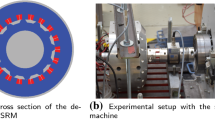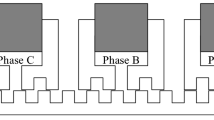Abstract
In addition to a high power to weight ratio, traction electric drives require a rather large range of speed regulation at constant output power. In the case of conventional electric motors, this is achieved by application of two-region regulation systems with magnetic flux weakening. A switched reluctance motor (SRM) with an extremely simple, manufacturable, and reliable design has a higher power to weight ratio within a range of moderate and high power values than do to conventional electric motors, while the regulation properties and limit characteristics in the zone above the rated speed have not been sufficiently investigated. The number of phases and magnetic-system configuration varying within a wide range and set by the ratio of the number of stator teeth to the number of rotor teeth significantly affect electromechanical characteristics in an SRM. In this paper, maximum values of speeds have been determined for basic configurations of SRM6/4 and 8/6 at similar rated speed, output power, and main magnetic-system dimensions. A simulation model of an SRM produced in the Matlab/Simulink environment shows that, when the speed of an SRM is increased, the output power is maintained by shifting the turn on and turn off phases in the forward direction. For selected conditions of comparison, it was found that, at preset parameters providing equal torques at low speed, the output power of SRM 8/6 at the rated speed is 20% higher than the power of SRM 6/4. At these parameters, the attainable range of speed variation at constant output power for SRM 6/4 is equal to 4.5 : 1, while it is 10% higher for SRM 8/6. If powers are balanced at the rated speed by means of reduced turning on of the interval of SRM 8/6 phases, then its range is increased to 7.9: 1, which is a significant advantage for some applications in transportation.
Similar content being viewed by others
References
Florentsev, S.N. and Izosimov, D.B., Traction electric drive in hybrid vehicles. Part 1. Design ideology of traction energy equipment, Elektron. Komponenty, 2011, no. 11, pp. 13–18.
Florentsev, S.N. and Izosimov, D.B., Traction electric drive in hybrid vehicles. Part 2. Design ideology of traction energy equipment, Elektron. Komponenty, 2011, no. 12, pp. 65–73.
Polfuntikov, E.Yu., Traction motor with permanent magnets, Sb. Nauch. Tr. Novosibirsk. Gos. Tekhn. Univ. 2009, no. 2(56), pp. 141–146.
Kozachenko, V.F., Ostrirov, V.N., and Lashkevich, M.M., Electric transmission based on the switched reluctance motor with independent excitation, Russ. Electr. Eng., 2014, vol. 85, no. 2, p. 115.
Kolomeitsev, L.F., Pavlyukov, V.M., Pakhomin, S.A., and Prokopets, I.A., Traction synchronous motor of induction type, Sb.: Nauch. tr.: Elektrovozostroenie. Vseros. nauchno-issl. proektno-konstr. in-t elektrovozostroeniya (Collection of Scientific Works: Electric Locomotive Manufacturing. All Russian Research and Development Institute of Electric Locomotive Manufacturing), 1991, vol. 32, pp. 64–69.
Nikiforov, B.V., Pakhomin, S.A., and Ptakh, G.K., Valve-induction motors for traction electric drives, Elektrichestvo, 2007, no. 2, pp. 34–38.
Bychkov, M.G. and Sussi Riah Samir, Formulas for determining the main sizes of valve induction machine, Elektrotekhnika, 2000, no. 3, pp. 15–19.
Petrus, V., Pop, A.C., Martis, C.S., Gyselinck, J., and Iancu, V., Design and comparison of different switched reluctance machine topologies for electric vehicle propulsion, Proc. 19th Int. Conf. on Electrical Machines. ICEM, Rome, 2010.
Takau, L. and Round, S., Design of a switched reluctance motor for an electric vehicle, Proc. 2003 Australian Universities Power Engineering Conf. AUPEC, Christchurch, 2003.
Bychkov, M.G., The way to analyze valve-induction electric drive by considering local saturation of magnetic system, Elektrichestvo, 1998, no. 6, pp. 50–53.
Krasovskii, A.B., The way to apply imitation simulation for researching valve-induction electric drive, Elektrichestvo, 2003, no. 3, pp. 35–45.
Krasovskii, A.B., Imitation models of traction valveinduction electric dive for solving typical design problems, Izv. Vyssh. Uchebn. Zaved. Mashinostr., 2012, no. 12, pp. 26–33.
Krasovskii, A.B., Forming conditions of output power stability in valve-induction electric drive, Elektrichestvo, 2002, no. 2, pp. 36–46.
Author information
Authors and Affiliations
Corresponding author
Additional information
Original Russian Text © M.G. Bychkov, V.N. Kuznetsova, S.A. Vasyukov, A.B. Krasovsky, 2015, published in Elektrotekhnika, 2015, No. 1, pp. 29–37.
About this article
Cite this article
Bychkov, M.G., Kuznetsova, V.N., Vasyukov, S.A. et al. Regulation capabilities of basic configurations of switch resistance motors for traction electric drives. Russ. Electr. Engin. 86, 22–28 (2015). https://doi.org/10.3103/S106837121501006X
Received:
Published:
Issue Date:
DOI: https://doi.org/10.3103/S106837121501006X




